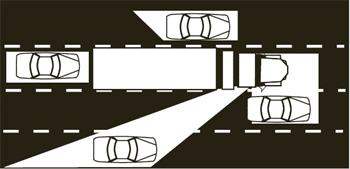Florida Driver's Handbook
Chapter 5: Driving Safety
5.37. Sharing the Road with a Truck
Whether you are sharing the road with a car, truck, bus, or other large vehicle, it's important for safety's sake to obey traffic laws, abide by the rules of the road, and drive defensively. Are there any special rules for sharing the road with a truck? Yes! Here are some suggestions from professional truck drivers.
5.37.1 - The "No-Zone"
- Blind Spots. Although most large vehicles have several rearview mirrors, it is easy for a car, motorcycle or bicycle to be hidden in a large vehicle's blind spot. Do not follow closely behind a truck or a bus. When driving near a large vehicle, be aware of the driver's blind spots on the right, left, front and behind.

- Rear Blind Spots. Unlike passenger cars, trucks and buses have deep blind spots directly behind them. Tailgating greatly increases your chances of a rear-end collision with a commercial vehicle.
- Unsafe Passing. Another "No Zone" is just in front of trucks and buses. When passing a bus or truck, be sure you can see the cab in your rearview mirror before pulling in front.
- Wide Right Turns. Truck and bus drivers sometimes need to swing wide to the left in order to safely negotiate a right turn. They cannot see cars directly behind or beside them. Cutting in between the commercial vehicle and the curb or shoulder to the right increases the possibility of a crash.
- Backing Up. When a truck is backing up, it sometimes must block the street to maneuver its trailer accurately. Never cross behind a truck that is preparing to back up or is in the process of doing so. Remember, most trailers are eight and a half feet wide and can completely hide objects that suddenly come between them and loading areas. Automobile drivers attempting to pass behind a truck enter a blind spot for both drivers.
5.37.2 - Passing
- When passing a truck, first check to your front and rear, and move into the passing lane only if it is clear and you are in a legal passing zone. Let the truck driver know you are passing by blinking your headlights, especially at night. The driver will make it easier for you by staying to the far side of the lane.
- On a level highway, it takes only three to five seconds longer to pass a truck than a car. On an upgrade, a truck often loses speed, so it is easier to pass than a car. On a downgrade, the truck's momentum will cause it to go faster, so you may need to increase your speed.
- Complete your pass as quickly as possible, and don't stay alongside the other vehicle.
- If the driver blinks his lights after you pass, it's a signal that it is clear to pull back in. Be sure to move back only when you can see the front of the truck in your rear-view mirror. After you pass a truck, maintain your speed.
- When a truck passes you, you can help the truck driver by keeping to the far side of your lane. You'll make it easier for the truck driver if you reduce your speed slightly. In any event, do not speed up while the truck is passing. After passing, the truck driver will signal to let you know that the truck will be returning to your lane.
- When you meet a truck coming from the opposite direction, keep as far as possible to the side to avoid a sideswipe crash and to reduce the wind turbulence between the two vehicles. Remember that the turbulence pushes the vehicles apart, it does not draw them together.
5.37.3 - Following a Truck
- In general, trucks take slightly longer than cars to stop because of their size. However, at highway speeds or on wet roads, trucks may have better traction and stability allowing them to stop more quickly. A car following too closely may not be able to stop quickly enough to avoid rear-ending the truck.
- If you are following a truck, stay out of its "blind spot" to the rear. Avoid following too closely and position your vehicle so the truck driver can see it in his side mirrors. Then you will have a good view of the road ahead, and the truck driver can give you plenty of warning for a stop or a turn. You will have more time to react and make a safe stop.
- When you follow a truck at night, always dim your headlights. Bright lights from a vehicle behind will blind the truck driver when they reflect off the truck's large side mirrors.
- If you are stopped behind a truck on an upgrade, leave space in case the truck drifts back slightly when it starts to move. Also, keep to the left in your lane so the driver can see that you're stopped behind the truck.
Florida Drug and Alcohol Course
Take your Florida Drug and Alcohol Course online with DriverLicenseSchool.com! Sign up by clicking the "GO" button below.
Florida Learners License Test
Take your Florida Learners License Test online with DriverLicenseSchool.com! Sign up by clicking the "GO" button below.
1-800-558-9887
